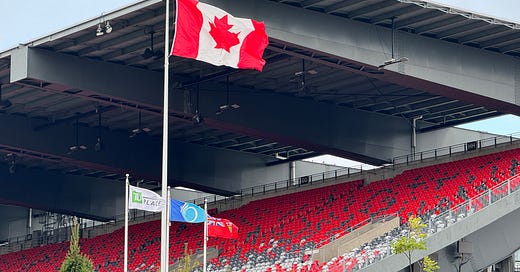The community fights back
Lansdowne 2.0 is far from decided.
But I’m hopeful that common sense will prevail.
Half a billion dollars to rebuild a sports stadium — which the City’s own consultant says is good for another 40 years with $40m in total maintenance and repairs.
Community voices are asking why would we spend that sort of money on a new stadium when we have a broken transit system and an urgent need for more affordable housing.
The community is fighting back.
Make no mistake. The odds are stacked against those of us who think Lansdowne 2.0 is a bad deal for taxpayers. This is a David and Goliath story, with a ragtag group of community volunteers lined up against the rich and powerful of Ottawa, who have the full support of the mayor.
But Sutcliffe’s Lansdowne is Ottawa’s version of Ford’s Greenbelt. We’re not going to take it without a fight.
We can win that fight if we keep up the pressure.
It will go back to staff for further work, development of new options and so on. But the current proposal is on shaky grounds.
Why?
The Lansdowne 2.0 proposal is a stinker. Half a billion dollars in corporate welfare for the Ottawa Sports and Entertainment Group. To add insult to injury, $6m of that money is being taken away from the City’s affordable housing fund. Think about that for a minute. We’re making the poorest in the City bail out the richest.
Councillors will not want to be seen repeating the mistakes of the LRT. Which is exactly what’s happening here. Justice Horigan, in his LRT Public Inquiry report, predicted exactly what we are seeing today: the mayor and city staff are holding back key information, preventing councillors from making informed decisions.
I can’t see how a majority of councillors support it.
How do we win?
Public pressure creates the political will to act.
We are the public pressure. And we have to keep it up.
We have to let councillors know that if they want to provide corporate welfare to OSEG, they are going to have to own it.
If you want to be a part of the solution, I have three suggestions.
1. Spend 15 minutes writing an email
Write a letter to a councillor. Not necessarily your councillor.
Here’s the text of one I recently sent. Make it original, keep it polite, and shorter is better.
Councillor
You’ve been a thoughtful voice on Council.
I haven’t heard your views on Lansdowne, and I hope you will come out soon and share with us where you stand.
For me, the decision on Lansdowne is obvious. Why spend half a billion on a new sports stadium — which the city’s consultant says we can keep going for another 40 years with about $750k in annual maintenance and repairs — when we have so many higher priorities including transit, housing and climate action?
I would be grateful if you could join those of your fellow councillors who have publicly shared their perspectives on Lansdowne.
Yours,
The Ottawa Councillors who most need to hear from you: Kitts, Carr, Gower, King, Hill. Find their contact info here.
Emails work! Councillors pay attention when they get a lot of correspondence on a certain topic. But avoid form emails — those often go straight into the garbage bin.
2. Speak for 5 minutes at Committee on Nov 2
This is a big ask, but if you feel strongly about Lansdowne, ask to speak in person or on Zoom at the November 2 Committee meeting.
To get on the speakers’ list, email Melinda.Aston@ottawa.ca and say that you would like to make a public delegation on Lansdowne at the joint Finance and Planning Committee meeting of November 2. Melinda will reply with all the details.
3. Join the Community Rally on Nov 2 at 8:45am at City Hall
The community is going to gather right before the Committee meeting, and send a message that thousands of people expect more from our elected representatives. That when it comes to how this city is governed, we’re not going to let insiders get away with giveaways.
Event details at betterlansdowne.ca.
This is our moment
Lansdowne 2.0 has evoked so much emotion, because it speaks to what sort of city we want to be.
Are we serious about fixing transit and providing more affordable housing?
Who does the city prioritize: its citizens or its business leaders?
Are we in the community, like with the greater Toronto greenbelt, prepared to stand up and say “enough is enough”?





